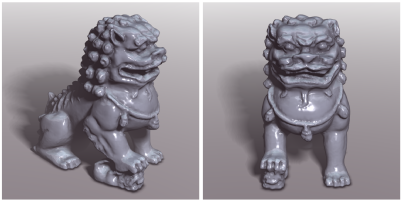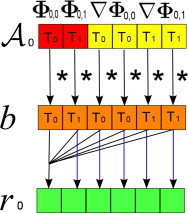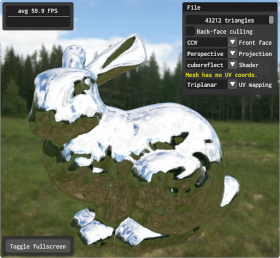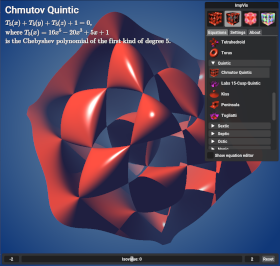|
I am an Associate Professor in the Center for Mathematics, Computing, and Cognition (CMCC) at the Federal
University of ABC (UFABC), Brazil. I specialize in the areas of computer graphics, digital image processing,
and computer vision. I also have experience developing 3D graphics applications and games, and am passionate
about leveraging modern C++ for creating interactive cross-platform graphics applications.
Recent projects
ABCg
C++20 framework that simplifies the development of cross-platform applications based on OpenGL, OpenGL
ES, WebGL, and Vulkan.
ABCg was designed primarily for the tutorials and assignments of the course "MCTA008-17 Computer
Graphics", but can also be used for full-fledged applications (see ImpVis below!).
ImpVis - 3D implicit function viewer
Impvis is an interactive tool designed for real-time visualization of isosurfaces and scalar
fields generated from 3D implicit functions. It provides a dynamic experience by allowing users to
modify the parameters and expressions of the function in real-time.
ImpVis is available for Windows, Linux, macOS, and WebAssembly.
Publications
SOUZA, V. L. T.; MARQUES, B. A. D.; BATAGELO, H. C.; GOIS, J. P.
Computers & Graphics. ISSN 0097-8493. 2023.
Generative Adversarial Networks (GANs) are a type of deep learning architecture that uses two networks
namely a generator and a discriminator that, by competing against each other, pursue to create realistic
but previously unseen samples. They have become a popular research topic in recent years, particularly for
image processing and synthesis, leading to many advances and applications in various fields. With the
profusion of published works and interest from professionals of different areas, surveys on GANs are
necessary, mainly for those who aim starting on this topic. In this work, we cover the basics and notable
architectures of GANs, focusing on their applications in image generation. We also discuss how the
challenges to be addressed in GANs architectures have been faced, such as mode coverage, stability,
convergence, and evaluating image quality using metrics.
CASACA, W.; GOIS, J. P.; BATAGELO, H. C.; TAUBIN, G.; NONATO, L. G.
IEEE Transactions on Pattern Analysis and Machine Intelligence. 43(8):2665--2681. 2021.

Seeded segmentation methods have gained a lot of attention due to their good performance in fragmenting
complex images, easy usability and synergism with graph-based representations. These methods usually rely
on sophisticated computational tools whose performance strongly depends on how good the training data
reflect a sought image pattern. Moreover, poor adherence to the image contours, lack of unique solution,
and high computational cost are other common issues present in most seeded segmentation methods. In this
work we introduce Laplacian Coordinates, a quadratic energy minimization framework that tackles the issues
above in an effective and mathematically sound manner. The proposed formulation builds upon graph
Laplacian operators, quadratic energy functions, and fast minimization schemes to produce highly accurate
segmentations. Moreover, the presented energy functions are not prone to local minima, i.e., the solution
is guaranteed to be globally optimal, a trait not present in most image segmentation methods. Another key
property is that the minimization procedure leads to a constrained sparse linear system of equations,
enabling the segmentation of high-resolution images at interactive rates. The effectiveness of Laplacian
Coordinates is attested by a comprehensive set of comparisons involving nine state-of-the-art methods and
several benchmarks extensively used in the image segmentation literature.
YAMADA, F. M.; GOIS, J. P.; BATAGELO, H. C.
In proceedings of the 2019 32nd SIBGRAPI Conference on Graphics, Patterns and Images. 116--123.
2019.

The Tangram is a dissection puzzle composed of polygonal pieces which can be combined to form different
patterns. Solving the Tangram is a two-dimensional irregular shape packing problem known to be NP-hard.
Tangram patterns may be composed of multiple connected components, and assembling them may require the
reflection transformation and unconstrained rotations of the pieces. In this work, we propose a novel
approach for the automatic solution of the Tangram based on a raster representation of the puzzle. In
order to adapt the geometrical techniques that are applied to the prevention of piece overlapping and the
reduction of space between pieces, we use morphological operators and representations commonly used in the
discrete domain such as the dilation operator, the distance transform and the morphological
skeletonization. We investigate the effects of the raster representation in the puzzle assembly process
and verify the effectiveness of the proposed method in solving different Tangram puzzles.
RAMOS, S.; TREVISAN, D. F.; BATAGELO, H. C.; SOUSA, M. C.; GOIS, J. P.
Computers & Graphics. 77:97--107. 2018.

The 3D reconstruction from a single 2D side-view sketch faces challenges in capturing details of
the curves and inferring the hidden parts. Here, we introduce an approach that ensures the 2D contours
are interpolated to a suitable 3D reconstruction while capturing the small details of the sketch.
To this end, we propose a novel strategy that combines a proper 3D Hermitian data generation from the
vicinity of the sketches with an approach for identification and completion of sketch curves. Feasible
3D models are then generated using Hermitian Radial Basis Functions (HRBF) Implicit Surfaces. Results
indicate that our approach provides not only more detailed 3D reconstructed models but also more
perceptual agreement from the input sketches in comparison to previous work.
GOIS, J. P.; MARQUES, B. A. D.; BATAGELO, H. C.
In proceedings of Graphics Interface 2015. 89--96. 2015.

Advances in computer-assisted methods for designing and animating 2D artistic models have incorporated
depth and orientation cues such as shading and lighting effects. These features improve the visual
perception of the models while increasing the artists' flexibility to achieve distinctive design styles.
An advance that has gained particular attention in the last years is the 2.5D modeling, which simulates 3D
rotations from a set of 2D vector arts. This creates not only the perception of animated 3D orientation,
but also automates the process of inbetweening. However, previous 2.5D modeling techniques do not allow
the use of interactive shading effects. In this work, we tackle the problem of providing interactive 3D
shading effects to 2.5D modeling. Our technique relies on the graphics pipeline to infer relief and to
simulate the 3D rotation of the shading effects inside the 2D models in real-time. We demonstrate the
application on Phong, Gooch and cel shadings, as well as environment mapping, fur simulation, animated
texture mapping, and (object-space and screen-space) texture hatchings.
BATAGELO, H. C.; GOIS, J. P.
International Journal of Image and Graphics, 14(1-2), 2014.

Ray tracing of implicit surfaces based on radial basis functions can demand high computational
cost in the presence of a large number of radial centers. Recently, it was presented
the Least Squares Hermite Radial Basis Functions (LS-HRBF) Implicits, a
method for implicit surface reconstruction from Hermitian data (points equipped with their normal
vectors) which makes use of iterative center selection in order to reduce the number of
centers. In the present work, we propose an antialiased Sphere Tracing algorithm fully
implemented in OpenGL Shader Language for ray tracing LS-HRBF Implicits, which
exploits a regular partition of unity for strong parallelization. We show that interactive
frame rates can be achieved for surfaces composed of thousands of centers even when
rendering effects such as cube mapping, soft shadows and ambient occlusion are used.
TREVISAN, D. F.; GOIS, J. P.; BATAGELO, H. C.
Journal of Computational Science, 5(5):701--708, 2014.

Hermitian radial basis functions implicits is a method capable of reconstructing implicit surfaces from
first-order Hermitian data. When globally supported radial functions are used, a dense symmetric linear
system must be solved. In this work, we aim at exploring and computing a matrix-free implementation of the
Conjugate Gradients Method on the GPU in order to solve such linear system. The proposed method parallelly
rebuilds the matrix on demand for each iteration. As a result, it is able to compute the Hermitian-based
interpolant for datasets that otherwise could not be handled due to the high memory demanded by their
linear systems.
GOIS, J. P.; TREVISAN, Diogo F.; BATAGELO, Harlen C.; MACÊDO, I.
The Visual Computer, 29:651--661, 2013.

In this work we investigate a generalized interpolation approach using radial basis functions to
reconstruct implicit surfaces from polygonal meshes. With this method, the user can define with great
flexibility three sets of constraint interpolants: points, normals, and tangents; allowing to balance
computational complexity, precision, and feature modeling. Furthermore, this flexibility makes possible to
avoid untrustworthy information, such as normals estimated on triangles with bad aspect ratio. We present
results of the method for applications related to the problem of modeling 2D curves from polygons and 3D
surfaces from polygonal meshes. We also apply the method to problems involving subdivision surfaces and
front-tracking of moving boundaries. Finally, as our technique generalizes the recently proposed HRBF
Implicits technique, comparisons with this approach are also conducted.
BATAGELO, H. C.; GOIS, J. P.
In proceedings of Graphics Interface 2013. 106--116. 2013.

HRBF Implicits have been used for the implicit
reconstruction of point clouds with normals. They yield superior results when compared to non-Hermitian
RBFs for the same number of centers and do not require offset points in order to avoid the trivial
solution. We propose a center selection criteria for HRBF Implicits based on an adaptive greedy algorithm
that takes into account function value, gradient and distance between centers. Residuals are computed
using a least-squares solution that takes into account all non-center points. As a result, the sampled
centers are globally well distributed (as in a Leja sequence), but at the same time preserve local
features. Because the method produces good reconstructions with few centers, it may be useful for
applications in which the implicit surface evaluation time is critical (e.g. real-time visualization).
GOIS, J. P.; BATAGELO, H. C.
In proceedings of 2012 25th SIBGRAPI Conference on Graphics, Patterns and Images Tutorials. 1--20.
2012.
Qt framework allows the easy development of professional cross-platform graphics applications using C++.
Qt provides the QtOpenGL Module that makes easy the development of hardware-accelerated graphics
applications using OpenGL and OpenGL Shading Language (GLSL). With Qt, matrices, vectors, vertex buffer
objects, textures, shader programs and UI components are integrated by classes in the object-oriented
paradigm and intercommunicate by the Qt mechanism of signals/slots. The goal of this survey is to detail
the development of interactive graphics applications with OpenGL and Qt. Along with it, we compare
features of QtOpenGL Module with those of GLU/GLUT libraries, as the latter is traditionally used in text
books and computer graphics courses.
Disclaimer: Federal University of ABC does not take responsability for the contents of this academic
page. Any opinions expressed herein should be construed solely as those of its author.
|









